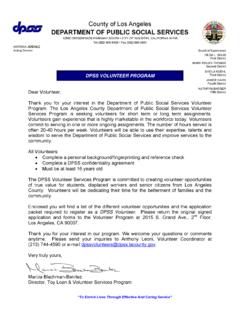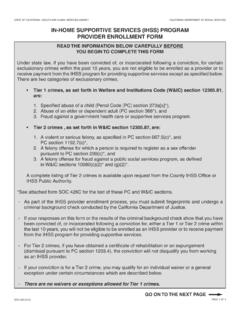Transcription of Los Angeles County Executive’s Office LA Probation ...
1 Los Angeles County executive s Office LA Probation governance study May 8, 2017 | 1 executive summary Introduction Driven by a large body of research, Probation departments across the country are beginning to implement new strategies and processes including evidence-based practices and community-based services, and placing increased emphasis on rehabilitation and youth development as a means for promoting public 2 Within this landscape, Probation agencies are now focusing on harm reduction by supervising only those who are appropriate for Probation supervision, for only the amount of time that is appropriate and effective, and by relying more on incentives like shortening Probation terms for good behavior, rather than sanctions like revocation and incarceration.
2 With the Probation profession experiencing a shifting paradigm, there is great need for guidance around identifying and implementing evidence-based and best practices to promote public safety, affect positive behavior change, and minimize the risk of This document is organized into four distinct sections focusing on evidence-based and best practices in: Probation Department Management, Structure, and Systems; Adult Service Delivery; Juvenile Service Delivery; and, Transitional Age Youth. Section 1. Probation Department Management, Structures, and Systems In this shifting environment, Probation departments find themselves having to make extensive changes, including shifts in organizational culture; staff hiring and training policies and practices; personnel management and supervision; the use of data and data systems; internal and external communication strategies; collaboration and partnerships; and contract procurement and management.
3 Moreover, at the same time that the Probation profession is changing,4 the American workplace is also under transformation. The use of computers and the practice of using data to inform all decision-making are now common practice both in the private and public sectors, and new generations of workers require that their jobs have purpose and be driven by a mission that they feel passionate 6 A critical component of any organizational culture is the establishment, implementation, and ongoing communication of a compelling and aspirational mission and vision for the future of the organization, as well as articulated values that are constantly reinforced. These statements guide organizational operations, progress, and shifts in Probation departments should reframe their mission toward the direct goals of being rooted in the community,8 affecting positive behavior change, and minimizing risk of To achieve these goals, a Probation department must explicitly embrace these concepts in its mission, vision, and Los Angeles County executive s Office LA Probation governance study May 8, 2017 | 2 Successful case planning, diversion, and reentry planning and support reduce recidivism and require authentic collaboration and coordination among multiple public agencies and community-based organizations.
4 Probation departments should intentionally foster structured partnerships with multiple public agencies and community-based organizations in order to meet the treatment, housing, educational, employment, and health-related needs of clients, and to result in better outcomes and reduced costs associated with these In addition, Probation departments should identify neighborhoods where large numbers of Probation clients live and establish offices and other operations in these neighborhoods in order to engage with indigenous supports, business associations, neighborhood organizations, faith leaders, and local service providers, and become more familiar with the types of services, supports, and opportunities available within the community.
5 Probations officers work should be oriented towards rehabilitation, and this should be reflected in job descriptions, recruitment efforts, and department trainings. Research demonstrates that higher educational attainment among Probation officers is associated with increased effectiveness working with youth;12 and that Probation officers working with youth (and TAY populations) should be trained in and implement developmentally appropriate supervision and intervention strategies. Probation staff should be diverse and reflect the communities they 14 15 Management practices in Probation include the management of both programs and personnel, as research shows that an evidence-based approach to program and personnel management, aligned with the principles of risk/need/responsivity, results in better outcomes and cost 17 Best practice recommends that Probation departments put in place performance-driven personnel management practices that promote and reward recidivism reduction, as well as the intermediary steps required to get there ( , use of new tools and strategies designed to target risks and needs).
6 18 19 Any organization concerned with the quality and impact of its services must track critical data elements over time to monitor improvements and identify areas of Client and agency-level data are needed to conduct performance assessments of a Probation department as a whole, and to assess the effectiveness of specific units, strategies, and staff The Probation department s executive management team should have a set of measurable goals ( , increased use of EBPs, reduced recidivism, reduced disproportionate minority contact, increased community collaboration) to collect data on, and should hold regular meetings to assess the data and decide what practices to change, maintain, and/or amend in order to meet 23 Los Angeles County executive s Office LA Probation governance study May 8, 2017 | 3 Section 2.
7 Adult Probation Services Research demonstrates that in order to reduce rates of recidivism, Probation officers should utilize validated risk assessment and need assessment tools. These tools determine each client's risk for recidivism and supervision intensity, including static and dynamic risk factors as well as service needs to be addressed through strengths-based case management and connections with A move toward a strengths-based case management approach which targets criminogenic needs, coupled with the utilization of validated risk assessments to guide supervision intensity and needs assessments to guide referrals to services has been one of the greatest shifts in community supervision. In addition to shifts in case management approaches, Probation officers are currently taking on additional responsibilities.
8 Probation officers are supervising larger numbers of pretrial individuals in order to help reduce jail crowding and minimize disruption in the lives of people who pose minimal risk to public safety and have not yet been convicted of criminal offenses,25 while also participating in pre-release planning for individuals who do spend time in custody. Probation should minimize the length of formal supervision, as research indicates there are diminishing returns to supervision after fifteen Probation departments should shorten the length of supervision for individuals who follow the conditions of their supervision in order to help reduce caseloads and allow for increased supervision intensity and access to resources for the highest risk For individuals under community supervision, Probation officers should take a strengths- based case management approach and use validated risk assessment and needs assessment tools to guide supervision practices ( , supervision intensity, referrals for services).
9 Several risk and needs assessment tools follow the risk, need, responsivity (RNR) model that identifies criminogenic risks, needs, and responsivity as key principles for reducing Probation officers should also implement structured decision-making processes in their approach in order to guide the provision of incentives and graduated sanctions. Jail and prison staff, Probation staff, and other County and community-based service providers must work together to meet the needs of individuals transitioning from custody to the community in order to help reduce recidivism and improve reentry outcomes. Probation officers should have a large role supporting the custody to community transition for individuals who will be under community supervision upon release.
10 In order to help establish a smooth custody to community transition, Probation officers should be staffed to work in County jails, if resources allow. Additionally, all Probation officers should provide in-reach services to individuals they will be supervising prior to their release. In-reach services should include clarifying expectations, conditions, and terms of supervision; reviewing individualized case plans; and, establishing referrals to community-based Los Angeles County executive s Office LA Probation governance study May 8, 2017 | 4 Assigned Probation officers should collaborate with the court by conducting pretrial investigations in order to help make evidence-based, informed decisions about releasing or detaining individuals As a part of the investigation, evidence-based agencies conduct objective pretrial risk assessments in order to evaluate the risk of flight and Moderate and high risk individuals should receive active supervision and meet with a Probation officer regularly (high risk more frequently than moderate risk individuals), either weekly or bi-weekly.













